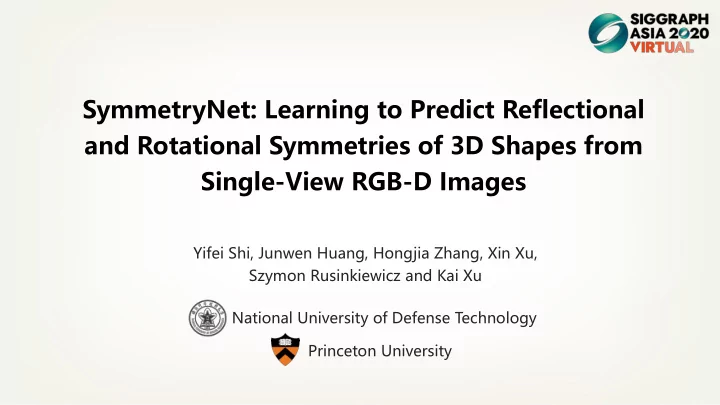

SymmetryNet: Learning to Predict Reflectional and Rotational Symmetries of 3D Shapes from Single-View RGB-D Images Yifei Shi, Junwen Huang, Hongjia Zhang, Xin Xu, Szymon Rusinkiewicz and Kai Xu National University of Defense Technology Princeton University
Motiv ivatio ion • Symmetry is omnipresent in both nature and the synthetic world
Motiv ivatio ion • Purely geometric symmetry detection approach ➢ Based on symmetry correspondences (counterparts) detection [Mitra et al. 2006] [Ecins et al. 2018]
Motiv ivatio ion • Detect object symmetries from a single-view RGB-D image ➢ Partial observation (self-occlusion) ➢ Mutual occlusion ➢ Noise • No sufficient symmetry correspondence • Learning-based approach?
Motiv ivatio ion • Naïve learning-based approach ➢ Training: memorize the symmetry axes of the category ➢ Testing: perform object classification & pose estimation Symmetry
Motiv ivatio ion • Symmetry is supported by local geometric cues ➢ Find local correspondence ➢ Aggregate and output symmetry • The searching of local shape correspondence benefits from the global feature
Our approach • Multi-task learning: predict not only the symmetry axis (global) , but also the symmetry correspondences (local) • Could detect multiple symmetries • Could handle both reflectional symmetry and rotational symmetry • End-to-end trainable
Rela lated work • 3D symmetry detection Partial symmetry detection Intrinsic symmetry detection [Mitra et al. 2006] [Xu et al. 2009]
Rela lated work • 3D symmetry detection View-based symmetry detection Slippage analysis Geometric fitting [Li et al. 2004] [Gelfand et al. 2004] [Ecins et al. 2018]
Problem settin ing • Input: an RGB-D image of an 3D object ➢ Object segmentation is known • Output: the extrinsic reflectional and rotational symmetries
Method • Symmetry prediction network point-wise point feature prediction CNN … … … global … MLP point-wise features feature Multi-task … PointNet learning … … … ground-truth weights Poin int-wis ise feature ext xtraction Poin int-wis ise symmetry ry prediction
Method • Loss function Dense point loss: Point-wise loss: ref. sym. or sym. parameters & rot. sym. or counterpart(s) location no sym.
Method • Loss function of reflectional symmetry The probability of point j being the counterparts of point i
Method • Loss function of rotational symmetry The probability of point j being the counterparts of point i
Method • Handle multiple symmetries … ground-truth Multiple symmetry Binary Optimal outputs classification assignment Point-wise features
Method • Inference ➢ Step 1: Prediction aggregation (Density-Based Spatial Clustering) ➢ Step 2: Visibility-based verification Prediction Verification aggregation …
Benchmark • We construct the 3D symmetry detection benchmark on … ➢ ShapeNet (synthetic) ➢ YCB (real) ➢ ScanNet (real)
Experiments • Qualitative results RGB-D image Predicted symmetry
Experiments • Qualitative results RGB-D image Predicted symmetry
Experiments • Qualitative results RGB-D image Predicted symmetry
Experiments • Qualitative results RGB-D image Predicted symmetry
Experiments • Compare to baselines ➢ Geometric Fitting [Ecins et al. 2018] ➢ RGB-D Retrieval [Yang et al. 2018] ➢ Shape Completion [Liu et al. 2020] • Evaluation metric ➢ Precision-recall curve [Funk et al. 2017]
Experiments • Compare to baselines on ShapeNet ShapeNet holdout category ShapeNet holdout view ShapeNet holdout instance
Experiments • Qualitative comparison RGB-D image Ground-truth Geometric Fitting RGB-D Retrieval Shape Completion Ours
Experiments • Qualitative comparison RGB-D image Ground-truth Geometric Fitting RGB-D Retrieval Shape Completion Ours
Experiments • Ablation study ShapeNet holdout category ShapeNet holdout view ShapeNet holdout instance
Experiments • Sensitively to occlusion
Experiments • Sensitively to occlusion light (50-60%) occlusion medium (60-70%) occlusion heavy (70-80%) occlusion
Experiments • Visualization of the predicted counterparts large error small error
Experiments • Runtime analysis
Failure cases • Spherical symmetry • Completely missing data
Applications • 6D pose estimation DenseFusion [Wang et al. 2019] DenseFusion + Symmetry prediction
Applications • Symmetry-based segmentation
Future work • Hierarchical symmetries • Self-supervised approach • Integrate symmetry prediction into X
Thank you
Recommend
More recommend